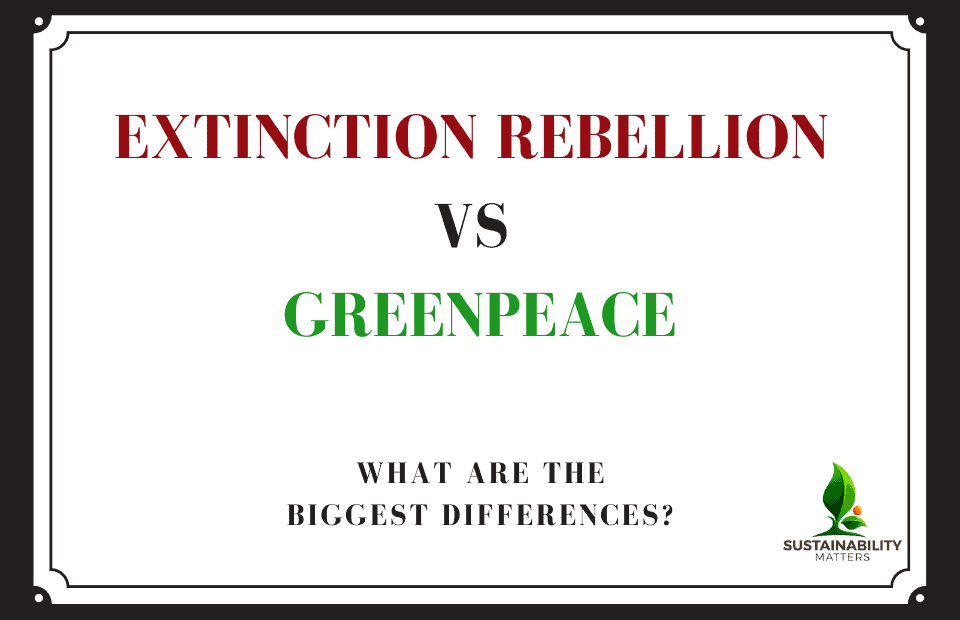Nearly 97% of climate scientists agree that human activities are the biggest culprit for climate change. This is not surprising given the increasing rates of greenhouse gas emissions and the continued overexploitation of natural resources.
Still, many don’t realize that if we don’t stop engaging in damaging activities, the changes will be catastrophic.
Following the increasing concern on environmental degradation, many initiatives have popped up in the past few decades. Greenpeace and Extinction Rebellion are examples of organizations formed to advocate for climate change actions. After all, they’re both quite famous. 🙂
In this article, we’ll provide a quick overview of these global establishments. I will focus on what they do, and their differences.
PS! I was actually having a job interview with Greenpeace back in the days. They were looking for a digital marketing manager in Oslo. If you want to know more about their hiring process, feel free to read this article.
Greatest Differences Between Greenpeace and Extinction Rebellion
In this section, we’ll be looking at the key differences between Greenpeace and Extinction Rebellion.
It’s a quite long article. Therefore I would like to give you a sneak peek of what we are going to look at:
- Mission – what is the ultimate goal?
- Objectives – which environmental issues are most important for each group?
- Historic roots – when, where, and how did it all begin?
- Structure – who is in charge? How are the organizations structured?
- Funding – who is paying for this madness?
- Groups targeted – are they only focusing on the government? Or do these groups also target private-owned businesses?
- Initiatives– examples of protests and other actions taken by XR and Greenpeace.
#1: Mission
Although Greenpeace and Extinction Rebellion advocate for mainly the same things, they are two entirely different organizations. Here’s a brief summary of each:
Greenpeace
This is a global movement formed to raise environmental awareness by confronting corporations and government authorities directly.
Established back in 1971, Greenpeace has garnered a lot of support since its inception. This can partly be attributed to its efforts in advocating for environmental conservation.
By searching for “Greenpeace Mission Statement” on Google, this information box popped up:

In other words, Greenpeace have a quite broad specter when it comes to what they try to achieve for the environment.
Extinction Rebellion
Usually abbreviated as XR, Extinction Rebellion is a global apolitical network. Their mission is to champion environmental conservation.
To achieve this, the movement uses civil disobedience and rebellion whenever necessary. Instead of relying on traditional advocacy systems like petitions and writing to government authorities, XR prefers taking risky moves (like arrests/jail time).
If you’re googling “Extinction Rebellion Mission Statement”, this comes up:

As you can see, there are quite different statements.
#2: Objectives
Although both Greenpeace and Extinction Rebellion champion for the conservation of the environment, they have differing objectives. Highlighted below are some of the issues that each organization focuses on:
Greenpeace
The primary goal of Greenpeace is to foster the earth’s ability to nurture life. However, there are other aspects that this organization advocates for such as:
Protecting Ancient Forests
Greenpeace understands that forests and their respective wildlife are threatened continually. This is mainly because of the overexploitation of natural resources.
This is why they advocate for the protection of plants and animals, particularly the endangered species.
Saving the Ocean
A large part of this organization’s mission is to protect the seas. This is not surprising considering the factors that threaten marine life. These include activities such as:
- Commercial fishing
- Fish farming
- Water pollution from ships and industrial wastes
- Oil spills
- Finding Renewable Sources of Energy
Another goal that Greenpeace hopes to achieve is to find renewable energy sources instead of fossil fuels. Using fossil fuels for energy almost always results in the emission of toxic gases to the atmosphere. That’s why alternative sources of energy are highly recommended.
Achieving Disarmament and Political Stability
Based on the Stockholm International Peace Research Institute (SIPRI), the world had an armory of 13,865 nuclear weapons as of 2019. Several countries have even been pursuing technologies that enable them to develop more nuclear weapons.
Due to this, one of Greenpeace’s primary objectives is to advocate for disarmament and peace. As a matter of fact, their first mission was to protest against nuclear testing.
Greenpeace has gone as far as to conduct public opinion polls, which reveal that most individuals are against the use of nuclear weapons. The organization uses statistics from such surveys to advocate for disarmament.
Minimizing the Content of Toxic Materials in Products
From mobile phones to desktop computers and cameras, electronics are manufactured using dozens of toxic materials. This makes it difficult to dispose of and recycle these gadgets.
Greenpeace is concerned about this, which is why they conduct intensive research on this topic. The organization then presents its findings to governments and recommends safer alternatives.
Extinction Rebellion
The movement’s primary goal is to compel governments to take action to protect the environment. As highlighted in the Extinction Rebellion website, their main demands from governments are:
Telling the Truth
The government should tell the truth by proclaiming a climate and ecological emergency. XR believes that if governments proclaim the climate crisis an emergency, then individuals will take it more seriously.
Achieving Net-Zero Emissions by 2025
The government should act now to stop the loss of biodiversity. More specifically, the government should do its best to minimize greenhouse gas emissions to net-zero by 2025.
The phrase net-zero means that any gases emitted by industrial plants get balanced out by absorbing an equivalent amount in the atmosphere.
Working in Conjunction with a Citizens’ Assembly
The government ought to form and be guided by the decisions of a Citizen’s Assembly regarding climate and ecological justice.
A citizen’s assembly is meant to empower people and communities by presenting them with an opportunity to participate in governance.
Essentially, XR brings ordinary people together. It gives them a right to investigate and make recommendations regarding the climate crisis.
Important to note is that the citizen’s assembly is representative of a country’s entire population. This means members are chosen based on their gender, ethnicity, age, education level, and geography.
#3: Historic Roots
Another factor that distinguishes these two organizations entails their different historical backgrounds. Let’s look at how each entity started.
Greenpeace
In the late 1960s, the U.S. military had planned to conduct an underground nuclear weapon test in Amchitka, Alaska.
Unfortunately, Amchitka was an island prone to earthquakes. Thus, there were growing concerns that conducting such a test would spark similar earthquakes and even tsunamis.
To prevent this, a group of activists set sail to protest against the nuclear test. Aboard the water vessel was Bill Darnell, who later on became one of the founders of Greenpeace organization.
Before the activists could arrive at Amchitka, they were intercepted by a U.S. navy ship. This meant that they could not go ahead with their protest campaign/plan.
While nuclear testing did not cause any severe repercussions on the island, it triggered a flurry of public interest. Not only did the government stop conducting nuclear tests, but it also declared Amchitka a bird sanctuary.
It is these events that led to the formation of Greenpeace in 1971. Other founders of the organization were Irving Stowe, Phil Cotes, and Jim Bohlen.
Extinction Rebellion
XR was established in the United Kingdom back in 2018. Roger Hallam and Gail Bradbrook are the core founders of the organization.
Roger, formerly an organic farmer, decided to study civil disobedience after climatic changes destroyed his business.
Bradbrook, on the other hand, is an academic and a former member of the Occupy London movement. The two individuals came together and formed the Extinction Rebellion, with the sole aim of mitigating the effects of climate change.
#4: Structure
A major difference between Greenpeace and Extinction Rebellion is that they have different forms of governance. Below, we’ll look at the structure of each organization.
Greenpeace
Greenpeace has evolved significantly from the simple group of environmentalists that it was in the 1970s.
It’s now a well-structured organization with headquarters in Amsterdam, Netherlands. The movement has 26 regional offices that operate in more than 50 countries.
Every regional office has an executive director, who is elected by a board of members from Greenpeace International.
This board meets once every year for the Annual General Meeting. During this gathering, the members discuss and determine the organization’s principles and other pertinent issues.
Greenpeace International is headed by directors Jennifer Morgan and Bunny McDiarmid. The current chair of the Board is Ana Toni. In total, the group has a staff of at least 2,400 and up to 15,000 volunteers across the globe.
Extinction Rebellion
Extinction Rebellion is a loosely organized movement. It follows a decentralized form of governance.
This means that their activities aren’t controlled from one central place, but from several different places.
In fact, if you undertake any action in quest of XR’s three objectives, and comply with its principles, you can claim to do it in the name of the movement. Other than individuals, local groups are also free to organize events independently.
#5: Funding
Another way in which the two organizations differ is the way in which they fund their activities.
Greenpeace
The main source of funding for Greenpeace entails individual donations.
However, this organization is pretty strict about where they get their funds from. To be specific, they reject any donations given by governments, businesses, and political parties.
All in all, they don’t accept funds from entities that might compromise their objectives and principles.
Extinction Rebellion
Extinction Rebellion, on the other hand, relies on crowdfunding, major donors, trusts, foundations, and NGOs. However, their main source of funding has been online crowdfunding.
Unlike Greenpeace, XR is a little bit lenient when it comes to the source of funds. There’s no mention of the organization rejecting funding from any particular entity.
Extinction Rebellion is also very transparent about how they use the funds raised.
#6: Groups Targeted By the Movement
Greenpeace and Extinction Rebellion both use non-violent civil disobedience actions to express their opinions. However, the two organizations are seen to target different entities.
Greenpeace
In an effort to advocate for climate change, Greenpeace works with all types of entities- from governments to corporations and individuals.
Extinction Rebellion
In contrast, the Extinction Rebellion directs its actions specifically to governments. Based on the evidence from this group’s activities, nearly all their actions are meant to compel government authorities.
#7: Initiatives Taken by Each Organization
Greenpeace and XR use fairly similar tactics. But a closer look at the activities of the two movements reveals that XR sometimes takes things too far.
Just last year, XR had planned to shut down Heathrow, one of the largest airports in London. While they did not go ahead with the protest plan, this shows just how disruptive some of their activities are.
Greenpeace
One of the main tactics that Greenpeace uses to advocate for climate change entails non-violent direct actions. Here are 4 actions the movement has undertaken in the past:
#1: Forceful Take-Over of Kent Power Plant
In October 2007, Greenpeace volunteers took over a coal-fired power plant in Kent, England. Their aim was to shut down the power station for as long as they could. They shut down the power plant as it was one of the biggest pollutants in the UK.
#2: Temporary Takeover of Cairn Energy Plant
60 Greenpeace activists -dressed as polar bears- occupied Cairn Energy’s headquarters in Edinburgh. Their aim was to find the company’s ‘Arctic oil-spill response plan’.
#3: Protest Against Shell’s Oil-Drilling Activity
In 2015, 64 activists from the movement marched to Shell’s headquarters in London to object oil drilling in the Arctic.
#4: The String Quartet Performance
In 2015, a few Greenpeace campaigners joined forces with ‘Art not Oil’ activists to perform a string quartet. Their aim was to protest against the British Museum’s partnership with the BP group which focused on creating an oil-dependent culture
Extinction Rebellion
In the short span that this organization has been in existence, it’s taken several actions to voice its demands. These include:
#1: Disruption of London Fashion Week events
In February 2019, XR activists created roadblocks outside London Fashion Week venues. This was to create awareness about the environmental effects of the fashion industry.
They even held a “fake funeral” to focus on the animals being killed as a result of cynical fashion industry:
#2: Fake Blood Protest on Downing Street
In March 2019, XR demonstrators poured buckets of fake blood on Downing Street. They did this to reflect that the lives of kids are threatened. Keep in mind that Downing Street is where the majority of official residences and houses are located.
#3: Spraying of Fake Blood on Treasury Building
Demonstrators from the movement also sprayed the front side of the Treasury house in London with fake blood. This was to protest against the government’s continued funding of projects that destroy the environment.
#4: Protest at Rockefeller Center Ice Skating Rink
With supporters from all over, XR has undertaken actions in other parts of the world too.
For instance, there was a protest held by XR members based in New York City. The activists marched to the Rockefeller Center ice skating rink and formed the extinction symbol using their bodies.
Conclusion
Climate change has become a growing concern for countries across the world. This is not surprising considering the effects it’s caused in nearly every sector.
Due to this, many organizations have popped up to shine a light on the devastating risks of climate change. Greenpeace and Extinction Rebellion are just some of the groups that have been formed to advocate for climate change actions.
Greenpeace is a non-profit environmental organization headquartered in Amsterdam, Netherlands. Extinction Rebellion (XR) follows a more loose-knit structure so it doesn’t have a specific base of operations.
Other than structure, the two organizations also differ in their source of funding, demands, and objectives.



In fact, XR doesn’t accept funding by governments, businesses, and political parties either.